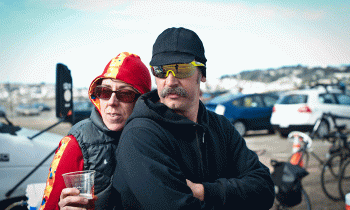April 30, 2000
Silicon Valley Magazine, Fitness Issue
By Karen Kefauver
During 10 grueling days in May, Terry Schneider will trek 300 miles from Tibet to Nepal during the notorious Raid Gauloises, the world’s premiere adventure race. She will hang from ropes on Himalayan peaks, plunge into roiling waters and gallop across plains on frisky horses as part of this multisport event, which is designed to test the mental and physical limits of its competitors.
After the race, she can succumb to exhaustion.
“I usually sleep half the day, then eat and sleep some more,” said Schneider, 38, a San Francisco-based professional athlete and personal trainer. A veteran of endurance races, she has found that, “It almost hurts more after the race when the swelling and bruises set in.”
Very gradually, Schneider resumes her training with stretching, walking and easy cycling.
Whether you are preparing for an adventure race, your first triathlon or 5K run, there is a good chance you are neglecting an important part of your fitness training — recovery.
“Most athletes miss the point of recovery,” said Gerard “GP” Pearlberg, 36, a certified track coach and owner of Great Performance Athletic Coaching in Santa Cruz. “They assume that you are getting fitter and faster when you keep pushing and pushing. But that’s not the case.”
It’s easy to neglect the concept of recovery in a tireless quest for conditioning, especially in a culture that promotes peak fitness and peak productivity no matter what the pursuit.
“Some people fail to realize that during a workout, the body is actually breaking down and the regeneration happens during rest,” explained Pearlberg, who also coaches the all-women runners’ group, Iron Maidens. Others may still adhere to the “no pain, no gain” principle or simply be unaware of the benefits of recovery.
Yet, true fitness comes only during recovery, said Pearlberg and other experts in the field of coaching concur.
So what is recovery?
“Recovery can be described as the period of time required by the human body to assimilate and regenerate from a specific workload and to compensate physiologically both within the musculoskeletal and central nervous systems,” said Pearlberg. “This process allows the body to handle those specific workloads in the future in a more economical and efficient manner.”
Think of recovery as “The 3 R’s:” Rest – getting enough sleep at night or grabbing catnaps; Refueling – making sure to replenish fluids and other nutrients; and Restraint – don’t return to your full routine all at once after a major effort.
It’s preferable to schedule your recovery into your workout the same way you do your activities.
That’s what Schneider does on the training programs she creates for her athletes. She always suggests a complete “rest day” for her clients, who include some first time triathletes with little experience swimming, running or bicycling.
An important factor in determining how much downtime you need is to ask yourself if you are exercising or training.
According to Dr. Warren Scott, who maintains Life Sport Medicine, a 15-year old sports medicine practice in Soquel, “training” means trying to go farther and faster while “exercising” means achieving a certain regularity at the same level of intensity — the goal is just to do it.
For the serious athlete, one who wants to push the performance envelope, Dr. Scott, the former chief of Sports Medicine at Santa Clara’s Kaiser Medical, said that “you have to have your own yardstick to measure yourself against” in order to assess how much recovery is needed.
Dr. Scott recommended monitoring a number of factors, primarily the heart rate response, body weight and fluid status on a regular basis in order to measure how the body is adapting to stress.
For some athletes, like Pearlberg, who won a gold medal in the 1500m at the 1998 Nike World Master Games, knowing what your body needs is a refined art developed after a number of years. Pearlberg runs seven days a week, but is careful to intermix easy days and difficult days.
“I make sure I always have a slow, easy run, preceding and following a tough day.”
For the entry level athlete, the role of recovery is less dramatic but still important. To combat soreness or stiffness, active recovery can be helpful.
“If you are sore from a run, that means that getting on a bike or swimming will leave your legs feeling refreshed, loosened up, rather than sitting on the couch,” said Dr. Scott.
For the light exerciser or beginner athlete, Dr. Scott also recommended focusing on cross training.
“If you don’t want injury, vary your exercise with a variety of stresses on the body, like one day golf, one day at the gym. Then you won’t need to worry about overuse or repetitive stress injury.”
“The physical element will vary a lot between individuals,” said Schneider. “But even for rookies, the best situation for your body is active recovery. The idea is to move around a little, and then start to ease back into training after that. You’ll feel better.”
She also cautions it is possible to do too much of a good thing.
“Don’t take too much down time,” Schneider advised. “I hear from people who took time off after an event and haven’t done anything in two weeks. It’s important to get back into your schedule.”
Regardless of individual fitness level, the consequences of not taking any or sufficient recovery time can be severe — injury, overtraining, sickness.
Some of the most common ailments, like tendonitis and muscle strains, occur when the musculoskeletal system starts to break down.
“When athletes profoundly ignore recovery,” noted Dr. Scott, who coordinates athlete care for the Hawaii Ironman Triathlon, “they become more susceptible to colds, may not sleep as well, and may become irritable. These are all symptoms of overtraining syndrome. This buildup will lead to chronic fatigue, lowered performance and slower races.”
“It’s common in the winter that people will get sick. No matter what level you train at you are always at the edge,” explained Pearlberg. “If you get sick, you take time off. Then the danger is when you make a comeback, you may try to jump in where you were six weeks ago, which can lead to a downward spiral.”
Shari Kain of Cupertino knows the agony of taking on too much too soon after an injury. A professional mountain bike rider for Team Polo Sport, Kain had back surgery in 1997 and then jumped back into training.
The pain returned and required a second back surgery. She had to take an entire year off. After the time out, she made a strong comeback and is now vying for a spot on the Olympic team for Sydney 2000. She has reformed her thinking, “I train hard and I rest hard.”
You don’t have to be in Olympic training to incorporate recovery into your program. What can you do?
· Listen to your body.
· Get coaching (see online references).
· Consult your doctor or nutritionist.
· Develop your formula for recovery
With the warm spring weather and the evening light, it’s easier to get motivated to shed those winter pounds, but it’s also tempting to overdo it.
“Inside everyone there is a little bit of a competitive athlete,” observed Dr. Scott. “Although you may say that you are just doing a ‘little race,’ you may have a secret desire to beat a husband, a wife, or a neighbor.” Let that competitor flourish without neglecting the recovery process.
For more information on fitness, coaching and training check out the following websites:
The following sites include coaching and fitness programs:
www.Asimba.com
With fitness, sports, nutrition and weight training information, this site offers a blend of tips for entry level and more advanced exercisers and athletes.
www.coachgp.com
Gerard Pearlberg’s site describes training programs and running workouts.
www.terryschneider.com
Terry Schneider’s site details her races and provides information about her training programs.
For a variety of fitness and health-related topics:
www.athletesvillage.com
Elite athletes, doctors and coaches provide advice and instruction.
www.fitnesslink.com
With a broad selection of articles on weight training and activities, this is for all fitness levels.
www.efit.com
From cooking and cardio to kids’ health to weight loss, there is plenty to review.
www.fitnessonline.com
This offers a wide spectrum of topics including health, allergies, pregnancy and training.
To find more resources, these sites provide links to more health and exercise sites:
www.exercise.about.com
www.dmoz.org/Health/Fitness
www.ultimatecoupons.com/diet-and-fitness-resource.html






